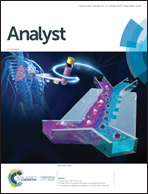Spatially resolved endogenous improved metabolite detection in human osteoarthritis cartilage by matrix assisted laser desorption ionization mass spectrometry imaging†
Abstract
Osteoarthritis (OA) is one of the most common musculoskeletal diseases, characterized by the progressive deterioration of articular cartilage. Although the disease has been well studied in the past few years, the endogenous metabolic composition and more importantly the spatial information of these molecules in cartilage is still poorly understood. Matrix-assisted laser desorption/ionization (MALDI) mass spectrometry imaging (MSI) has been previously used for the investigation of the bimolecular distribution of proteins and lipids through the in situ analysis of cartilage tissue sections. MALDI-MSI as a tool to detect metabolites remains challenging, as these species have low abundance and degrade rapidly. In this work, we present a complete methodology, from sample preparation to data analysis for the detection of endogenous metabolites on cartilage by MSI. Our results demonstrate for the first time the ability to detect small molecules in fragile, challenging tissues through an optimized protocol, and render MSI as a tool towards a better understanding of OA.



 Please wait while we load your content...
Please wait while we load your content...